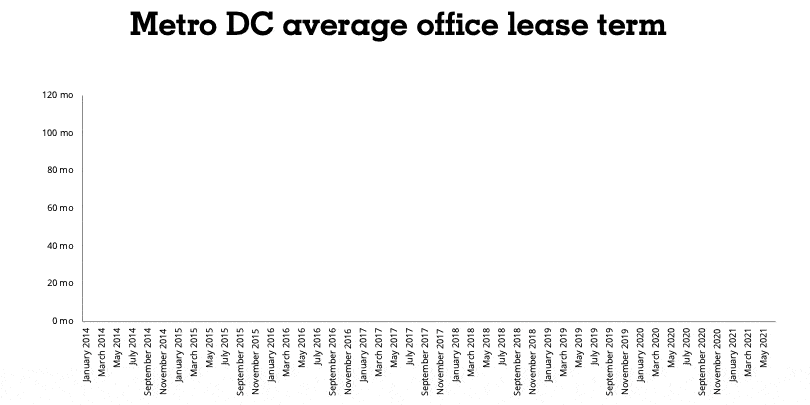Average lease lengths show small tenants' hesitancy to commit to office

13.4% post-pandemic lease term drop for small tenants
As tenant activity across Metro DC begins to thaw from a COVID-induced freeze, flexibility has reached paramount importance for the office leasing market. This trend has manifested via shortening lease terms: among tenants larger than 10,000 sf, the 12-month trailing average lease term declined modestly from 101.9 months in March 2020 to 96.9 months as of June 2021, a 4.9% drop. Tenants smaller than that, however, averaged a much more substantial drop of 13.4% over the same period, from 66.6 months to 57.7 months.
The COVID-19 vaccine rollout is well underway and many of the restrictions aimed at curbing viral spread have been lifted, yet small-tenant lease terms appear to remain in decline. This could suggest that small tenants are permanently seeking increased flexibility, as the pandemic highlighted the potential risk of committing long-term. Some tenants may find this flexibility via coworking, a sector that was pummeled by the pandemic (contracting nearly 15% regionally) but that has seen increased interest as the economy reopens. According to Google Trends, nationwide searches for “coworking” increased 45% in May 2021 in comparison to the prior 11 months, and Washington, DC ranked first in the nation by a wide margin.
Regionally, 64% of tenants fall into the sub-10,000-sf category, but thanks to their small size, these tenants’ square footage adds up to just 17.6% of leased space. Therefore, while plummeting lease terms have the potential to harm landlords and their asset values, it is worth noting that most of the impact is confined to a minority share of the office market. Moreover, landlords that are willing to get onboard with the trend toward flexibility may find it provides a differentiator in today’s increasingly competitive leasing environment. Given that many small tenants have also been putting off their leasing decisions throughout the pandemic, a combination of speed to market (via spec suites, for example) and willingness to accommodate two- to three-year lease terms could help landlords capture an outsized share of leasing in the near term.
Source: Avison Young. Figures on the graph reflect trailing 12-month average lease terms.

Snack-sized data that fills you with delight and insight.
